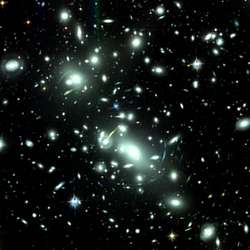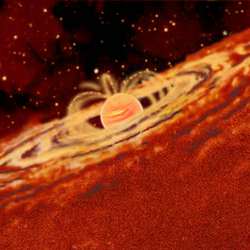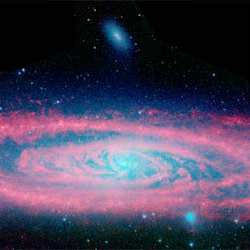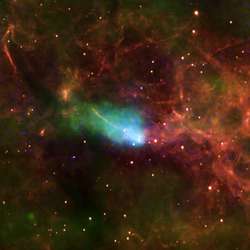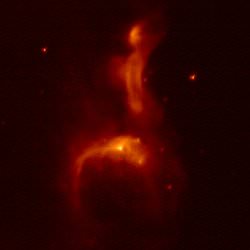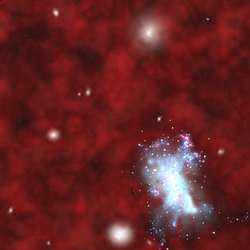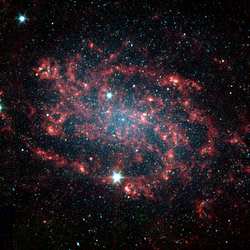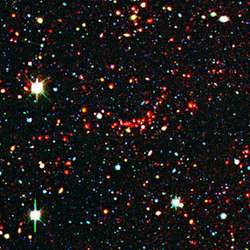
Distant clusters of galaxies. Image credit: NASA/JPL-Caltech. Click to enlarge
NASA’s Spitzer Space Telescope has turned up 300 galaxy clusters at extreme distances; 8 – 10 billion light-years away. Galaxy clusters have been seen at extreme distances before, but never so many. This gives astronomers the ability to study their formation and evolution with many different examples. The discovery was made by combining images from Spitzer and optical light telescopes, to identify which galaxies are relatively nearby, and which are more distant.
A team of astronomers using NASA’s Spitzer Space Telescope has discovered a grand total of nearly 300 clusters of galaxies. Almost 100 of these are as far as 8 to 10 billion light-years away, which means they date back to a time when our universe was less than one-third its present age.
Galaxy clusters are the universe’s high-density environments, similar to cities on Earth. A single galaxy cluster can contain hundreds of galaxies like our own Milky Way.
“At this distance, we are literally looking at these galaxies as they were over 8 billion years ago,” said Dr. Mark Brodwin of NASA’s Jet Propulsion Laboratory in Pasadena, Calif., who co-led the discovery. “It’s like being able to take a picture of Rome during the peak of the Roman Empire.”
Brodwin presented the results today at the 208th meeting of the American Astronomical Society in Calgary, Canada.
Such observations should lead researchers to a better understanding of how massive galaxies form and evolve. “The oldest and most massive galaxies in the universe live in clusters,” said co-discoverer Dr. Anthony Gonzalez of the University of Florida, Gainesville. “This sample is exciting because, for the first time, we are able to look at these massive cluster galaxies while they are still forming and better understand when they formed their stars.”
While galaxy clusters have previously been found at similar distances, this is the first time that so many clusters have been detected so far away. In December of 2005 and March of 2006, the team reported finding two galaxy clusters located 9.1 and 8.2 billion light-years away, respectively. Today, they announced the discovery of 290 clusters of varying distances, some of which are referred to as galaxy “groups” because they contain fewer members. The nearly 100 distant clusters and groups belonging to this sample represent a six-fold increase over what was previously known.
According to the astronomers, the key to their success was a combination of infrared and optical imaging from Spitzer and Kitt Peak National Observatory in Arizona. The distant galaxies making up the clusters light up in the infrared images, but they cannot be distinguished from other galaxies lying between us and them. By combining the Spitzer images with those from Kitt Peak showing mainly the intervening galaxies, the scientists were able to isolate the distant ones. Finding the clusters of distant galaxies then becomes simply a matter of looking for dense clumps of distant objects.
“Distant galaxies show up best in infrared because during the billions of years it takes to reach us, their light expands along with the universe to longer, infrared wavelengths,” said team member Dr. Peter Eisenhardt of JPL, who led the Spitzer observations.
“With Spitzer, we were able to make deep infrared maps thousands of times faster than with the biggest ground-based telescopes, covering enough sky to find these relatively rare clusters. By adding the deep Kitt Peak optical maps, we could weed out all the galaxies cluttering up the view between us and these distant clusters.”
So far, the distances to seven of the farthest clusters identified have been confirmed using detailed data from the W.M. Keck Observatory in Mauna Kea, Hawaii.
The team will continue to study these ancient galactic cities using Spitzer and NASA’s Hubble Space Telescope. They hope to begin tackling two major questions: just how big are these cities, and how do they grow?
Brodwin is a native of Canada from Montreal. Other team members include: Dr. Adam Stanford of the University of California at Davis; Dr. Daniel Stern of JPL; Drs. Buell Jannuzi and Arjun Dey of the National Optical Astronomy Observatory, Tucson, Ariz.; and Dr. Michael J. I. Brown of Princeton University, Princeton, New Jersey.
JPL manages the Spitzer Space Telescope mission for NASA’s Science Mission Directorate, Washington. Science operations are conducted at the Spitzer Science Center at the California Institute of Technology in Pasadena. Spitzer’s infrared array camera, which observed the galaxy clusters, was built by NASA’s Goddard Space Flight Center, Greenbelt, Md. The instrument’s principal investigator is Dr. Giovanni Fazio of the Harvard-Smithsonian Center for Astrophysics.
Kitt Peak National Observatory, part of the National Optical Astronomy Observatory, is funded by the National Science Foundation and located on the land of the Tohono O’odham Nation.
Original Source: Spitzer Space Telescope

